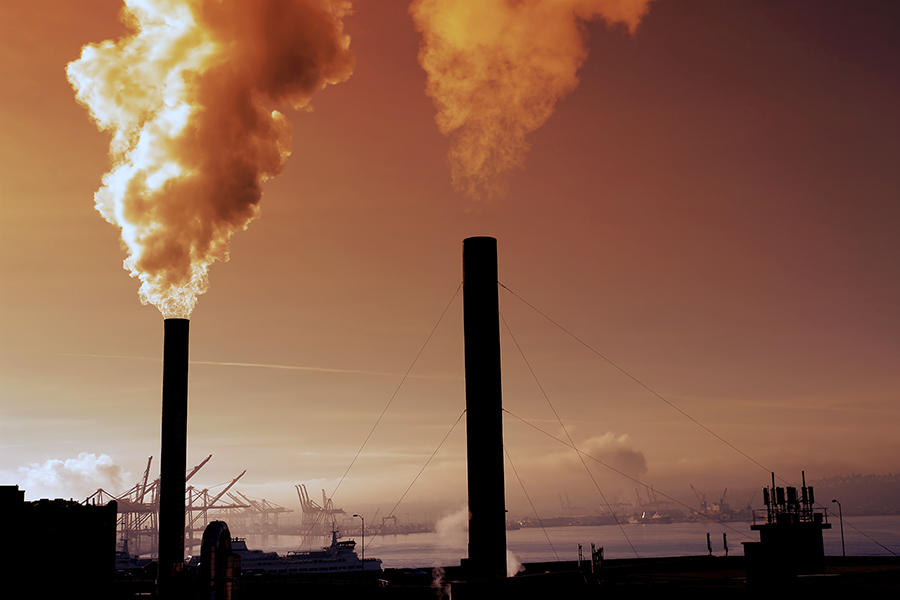Chemical air pollution, non-compliance, and why you should care
April 28, 2021
Pensacola, Florida is known for its beautiful beaches, parks and nightlife. However, floating directly above these picturesque scenes are fine particles that are the cause of a variety of environmental and health issues.
Hydrochloric acid, ammonia, methanol and arsenic are among the numerous toxins released into Pensacola’s air every year. These toxins are accompanied by many potential health risks which will be discussed further on.
According to the Environmental Protection Agency’s Toxic Release Inventory (TRI) program, zip code 32514 releases over 20 million pounds of chemical toxins annually.
The zip code covers Brent, Ferry Pass and part of Pace. There are 14 separate facilities that are responsible for the chemical pollution in that area.
The TRI program website states that the weight of toxic releases in 2019 from these facilities was 28,739,788 pounds. Of this total, 674,925 pounds were released into the air.
According to the Florida Department of Environmental Protection (FDEP), “the U.S. Environmental Protection Agency has set the National Ambient Air Quality Standards for six criteria pollutants to safeguard human health and the environment: carbon monoxide, lead, nitrogen dioxide, ozone, particulate matter, and sulfur dioxide.”
While most facilities and businesses are required to have an air operation permit to decrease the spread of these chemical pollutants, it is available for businesses to be exempt. These exemptions are dependent on “the potentially applicable regulations, equipment size and emissions levels” of these businesses.
The Florida Administrative Code (FAC) actually allows small businesses to opt-out of getting a permit, according to the FDEP. That means that smaller businesses can opt-out of permits that lay out the criteria and conditions that are designed to protect Florida’s air quality.
Each facility has a permit that is specific to that facility’s operations. The Air Permit lays out the terms and regulations each facility must comply with, and what the repercussions are for non-compliance.
The FDEP takes several concerns into consideration when addressing non-compliance. Brandy Smith, the FDEP’s external affairs manager, said this about repercussions concerning non-compliance:
“The nature of the violation, environmental impact, and the compliance history are all considered when determining which option is most appropriate. If a violation occurs, the department may obtain a return to compliance by informal means. A prompt return to compliance without formal enforcement is the preferred means to correct a violation committed by a person who did not know that the person’s actions were contrary to law, or whose actions were inadvertent, or if the violation caused no more than “minor harm.” An inadvertent violation is one that occurs despite the good faith efforts of the responsible party to comply with the applicable requirements.”
If it is determined that more formal enforcement is appropriate, department staff can pursue administrative or civil penalties and corrective actions. The imposition of penalties is an enforcement tool that is intended to ensure immediate and continued compliance by the subject of the action and by others who may face a similar situation in the future.
While there is a penalty system in place, there is no regulation that outlines how many violations a facility can have before being shut down. The penalties can be increased depending on the facility’s continuous non-compliance. This means that if a facility continuously does not comply with the regulations in place to protect Florida’s public health and environment, it can continue operating and only face penalties. There is rarely any threat of having these facilities shut down.
Smith also said that the FDEP can seek “injunctive relief for ongoing violations.” Injunctive relief, according to the Legal Information Institute, is “a remedy which restrains a party from doing certain acts or requires a party to act in a certain way. It is generally only available when there is no other remedy at law and irreparable harm will result if the relief is not granted.”
Permanent injunctions, which essentially shut a facility down, can be part of the court’s final decision, but it is very rare. There has only been one filing for injunctive relief due to violating the Clean Air Act since 2010 and it was not a permanent injunction.
When I asked how non-compliance affects the public and environment, the FDEP stated that Florida’s legislature has “passed laws restricting or prohibiting activities that may cause pollution, harm the resources of the state, or threaten human health or safety. The department is committed to its mission and enforcing Florida’s environmental laws to protect the public and the environment.”
This, to me, did not answer the question. So, what are the risks associated with facilities not complying with Florida’s laws and regulations?
According to the TRI program, the top five toxins released into 32514’s air are hydrochloric acid (27%), sulfuric acid (20.9%), styrene (19.5%), ammonia (12.4%), and miscellaneous (15.4%). The percentages represent the chemical’s portion of the total of released toxins.
These chemicals have health and environmental threats associated with them. According to the Environmental Protection Agency (EPA), people who have been or are exposed “to toxic air pollutants at sufficient concentrations and durations may have an increased chance of getting cancer or experiencing other serious health effects. These health effects can include damage to the immune system, as well as neurological, reproductive (e.g., reduced fertility), developmental, respiratory and other health problems.”
Thankfully, Pensacola is seeing an upward trend in air quality with less hazardous air pollutants. However, risks to the public’s health are still a reality that people need to be aware of.
Environmentally, health issues are also of concern. Much like humans, animals can experience health problems from air pollution, too. According to the Massachusetts Department of Environmental Protection (MassDEP), air toxins are “contributing to birth defects, reproductive failure, and disease in animals.” This can affect wildlife biodiversity.
According to a review posted on The National Center for Biotechnology Information’s website, chemical air pollution can cause eutrophication. This is when high concentrations of nutrients prompt aquatic algae to bloom, which causes an imbalance between the diversity of fish and may increase their death rates.
Environmental effects of air pollution also include contributing to global climate change and “haze.” Haze happens when fine particles are released into the air and cause the visibility of the atmosphere to decrease. According to the review mentioned above, haze is “caused by gas emissions in the air coming from industrial facilities, power plants, automobiles, and trucks.”
At the University of West Florida, which is close to the center of 32514, the air pollution is almost tangible. I spoke to a couple of students at the university to see if air pollution from nearby factories affects their personal life.
Jessica Ethridge, a sophomore at the university, said that when she takes walks on the nature trails on campus, she can “not only see but smell grey masses of smoke” coming from the mill just off campus. When asked how Etheridge felt about the air pollution in Pensacola, she said that all she wants to do is hold her breath. Etheridge also said that “knowing that excessive pollution is being released into the air that I breathe daily really makes me wonder how clean our air is. What concerns me more is knowing that human factors are the cause for this pollution.”
Hunter Brown, who has grown up in Pensacola and is a student at the university, explained his experience with air pollution. He said that the smoke from the Gulf Power plant sometimes causes a haze across the university’s campus and makes everything smell like smoke.
Brown went to Tate high school which is in close proximity to the International Paper Co. mill. He said that the “air quality is poor and it is very, very common that you can smell the rancid smell from the plant.” He also stated that “ [the paper mill] makes the entire area of Cantonment smell like garbage all the time.”
These are just two people who live and breathe this air pollution, as a population of 42,444 people live in the area code 32514. This means that almost fifty thousand people are affected by air pollution, daily, in just a single part of Florida.
This type of poisonous pollution needs to be firmly cut off. The repercussions for violating the regulations and laws set in place to protect Florida’s public and environment need to be more than a slap-on-the-wrist kind.
People in Florida, specifically in Pensacola, are breathing, drinking, living in this pollution. It is time to bring awareness and put a stop to it.


